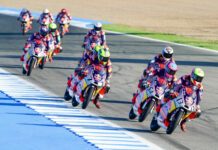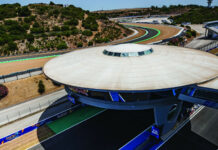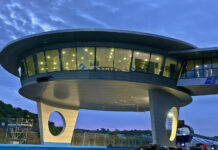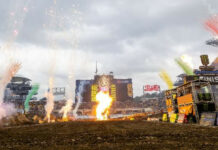From a Marlboro Yamaha press release:
MARLBORO YAMAHA MEN BRING MOMENTUM TO THE CATHEDRAL
The Marlboro Yamaha Team and riders Max Biaggi and Carlos Checa come north to the Netherlands this weekend, gathering momentum after impressive performances at the last three GPs. The hard-working squad has scored a podium finish at each of the last three races, with Biaggi crowning the M1’s recent progress by achieving the bike’s first-ever pole position at Catalunya two weekends ago.
That success proved that the M1 now has pace-setting speed, all that remains now is for Biaggi or Checa to score the bike’s first victory in the new four-stroke-based MotoGP World Championship. Both men have high hopes for Assen, for the Dutch circuit is a rider’s track, known as the cathedral of bike racing, where they should be able to combine their riding talent with the M1’s ever-improving performance to devastating effect.
The first-ever Dutch TT of the new four-stroke GP era is a particularly significant event, for Assen is the most historic venue on the World Championship calendar. Even the event’s name is ages old – Assen is the only world round to use the suffix, TT for Tourist Trophy, the designation used for the earliest speed events of the last century. Originally based on public roads, the sinuous circuit is the only survivor from the inaugural 1949 world series, when four-strokes ruled the racetracks before two-strokes took control in the sixties and seventies. The fastest and longest GP circuit, Assen has seen bike racing change in all kinds of ways, both technically and commercially. Assen’s infrastructure has been hugely upgraded over the decades, 23 million euros invested in improving the track and facilities over the past three years alone.
Two things that haven’t changed, however, are the event’s unusual and traditional Saturday race day and its enormous popularity. Assen still regularly draws crowds of up to 150,000, many of them from around the Netherlands and Germany, even though these nations have few major-league GP stars to cheer. The Dutch TT is simply one of those unmissable races – with an atmosphere all of its own and a sense of history like few others.
Neither can this year’s event escape the realities of the outside sporting world. Saturday’s schedule has been changed to allow football fans to watch the World Cup’s third-place playoff. Instead of the usual 2:00 pm start, MotoGP action begins at 3:30 pm.
BIAGGI – READY FOR THE NEXT LEVEL
Max Biaggi has every reason to approach the Dutch TT with a growing sense of optimism. Two weeks ago at Catalunya the hard-riding Marlboro Yamaha Team YZR-M1 rider scored his first pole position of the new MotoGP four-stroke era, outpacing the rival four-strokes from Honda, Suzuki and Aprilia. The artfully talented Italian has scored an amazing 49 pole positions in his 11-year World Championship career, one in MotoGP, 15 in 500 and 33 in 250.
But, as former Marlboro Yamaha World Champion Eddie Lawson (an Assen winner in 1987) once said: “There are no points for practice”. So, having proved that the M1 can be the fastest bike out there, Biaggi is now focused on taking the 200 horsepower-plus machine to the next level – race victory.
“Pole is only one lap but it does mean something and it’s a good morale booster for the rider and team,” says Marlboro Yamaha Team director Davide Brivio. “Max is riding so hard at the moment and that pole position will give him even more motivation as he gets closer to winning his first race on the M1. He’s had three great GPs. He finished third at Le Mans, second at Mugello and then he got pole at Catalunya. He finished that race fourth and I’m sure he would’ve done better if he hadn’t had an unlucky problem in morning warm-up that forced him to race his number-two bike.”
Saturday’s Dutch TT could well be the event at which Biaggi achieves his next goal, for which he has been working so hard since the advent of the four-stroke MotoGP era. The former 250 World Champion has scored three wins at this most challenging of circuits, which rewards the kind of inch-perfect riding technique for which Biaggi is renowned. He won last year’s shortened 500 race at the track, following up his 250 successes there in 1994 and ’95.
“Assen is a very nice track, it’s fast and very hard work, but I enjoy it,” says Biaggi, who celebrates his 31st birthday the day before practice commences. “I don’t really know how it will be for the four-strokes because none of the tracks we’ve been to so far are anything like it, but it should be good, I think.”
Assen is different from modern purpose-built racetracks because it was once a winding public road. Even the straights aren’t straight. And unlike other tracks, many of the corners are cambered. Some riders find this awkward, even dangerous, but Biaggi’s super-smooth and flowing style works superbly at Assen.
“I don’t mind the camber,” he affirms. “You have to adapt your riding style because it’s a different kind of a racetrack, but then you have to slightly change your style for every circuit and I never have a problem doing that. The surface is also very grippy, one of the grippiest circuits we go to, but it’s been resurfaced for this year and the layout’s a little different, so maybe the grip has changed.
“The biggest concern at Assen is always the weather. It can be very changeable, which can rob you of dry-track time in practice, and you need all the set-up time you can get at Assen, because it’s such an unusual and complex circuit.”
Biaggi currently lies fourth overall in the 2002 MotoGP World Championship, equal on points with team-mate Carlos Checa but one position in front, thanks to his second place at the Italian GP, the M1’s best race result so far.
CHECA BACK UP FRONT AGAIN
Carlos Checa ended a run of three difficult GPs at Catalunya a fortnight back and comes to Assen determined to do even better than the third place he managed at the testing Spanish track. With his run of bad luck seemingly at an end, Checa was back up front and battling for victory with Honda rivals Valentino Rossi and Tohru Ukawa. The Marlboro Yamaha Team man led half the race on his YZR-M1 after starting from the second row, and though he ended up third, the result was a considerable boost to his morale.
“After three unlucky races, Carlos finally got a good result at Catalunya,” says Marlboro Yamaha Team director Davide Brivio. “It was the best place for him to get back on track, and the local fans really loved him for what he did. We will need to improve the bike’s handling for Assen because it’s a high-speed circuit which demands ease of handling. Also, we should be able to try some different engine specs during the weekend.”
Checa and team-mate Max Biaggi have worked particularly hard this season, toiling with their crews and Yamaha engineers to bring the M1 up to speed after a difficult start to the year. Although Checa scored a third-place finish at the season-opening Japanese Grand Prix, it took a serious input from Yamaha to bring the M1 to full competitiveness. Since preseason testing the M1 has benefited from a whole raft of improvements to its engine, chassis and electronics, following input from both riders.
Yamaha have run two new chassis since the start of the season, the latest of which improves braking stability, solves chatter problems and offers better front-end feel. Engine upgrades have included modified camshafts, cylinder heads, crankcases and many other parts. Peak horsepower has increased by more than ten horsepower since April’s Japanese GP (at the Catalan GP the bike hit 315.8kmh/196.2mph, 12.1kmh/7.7mph faster than during preseason tests at the track).
Perhaps most interesting of all is the M1’s computer-controlled engine-braking system, which controls the bike’s slipper clutch to increase stability and thus improves rider control in the all-important corner-entry zone. Recent upgrades to the unit have included new software which operates via an increased number of engine and chassis parameters, like gear position, throttle position and brake pressure.
Both Biaggi and Checa have played their parts in the introduction of all these improvements, and are now more than ready to take advantage of the M1’s increased performance.
“The combination is now working really well,” says Checa, who currently lies fifth overall, equal on points with Biaggi. “We have come a long way since the start of the year, I feel much more comfortable on the bike and I think we now have a great opportunity for some good results. My feeling for the chassis is better, the engine-braking system gives us what we want into
corners and the engine is more powerful.
“I’m looking forward to getting to Assen to try out the changes they’ve made to the track. That shouldn’t be a big job because most of the layout is the same as before, though it’s been resurfaced and that could change things. Assen is a very different circuit, it’s unique really. Even the straights aren’t really straight and most of the corners are banked and very fast.
Also, there’s very little room between the white lines and the grass, which means you’ve got to be perfect with your lines. I like the layout a lot and I appreciate riding on different kinds of tracks, it’s great to have some variety, it stops me getting bored! Assen should be good for the four-strokes because it’s fast and you carry a lot of speed all round the lap.”
WHAT THE TEAM SAYS
Davide Brivio, Marlboro Yamaha Team director
“We’ve now had three GPs in a row at three different tracks – Le Mans, Mugello and Catalunya – in which we’ve been right there. That’s an important sign of the M1’s increasing competitiveness. And Catalunya confirmed that the bike is still getting better and better; Max did brilliantly to give the M1 its first pole position and Carlos led half the race and got back on the podium. We are on the pace, now we just need to make that next step towards winning. It’s been a hard few months since the start of the season but the whole team has reacted incredibly well. Everyone has given their all and I’m delighted that we’re now getting some results. Now we need to keep working just as hard to get our first win!”
Fiorenzo Fanali, Max Biaggi’s chief engineer
“Assen is a very unusual racetrack, you have to change the chassis settings to cope with the banked corners. It’s also a track with no real straights, the rider is always turning one way or another, so easy handling is very important. It’s a fast circuit where riders keep their rolling speed, it’s not at all stop and go, which could help the two-strokes. The M1 gets better every weekend but we need to continue working to maintain the progress we’ve made since preseason testing.”
Antonio Jimenez, Carlos Checa’s chief engineer
“Assen’s character is high speed with banked corners, but it’ll be a little different this time because the layout has changed slightly and the track has been resurfaced. In the past it’s always been extremely grippy, which means you run a really hard rear spring because of the high g-forces, to prevent the bike from running wide on the gas. But we’ll have to wait and see this time. Catalunya was great for Carlos, and, all being well, I think he’ll be fighting for the podium at every race from now on. We’ve just got to keep working to improve the bike some more, and if we do that I’m fully confident that we will win a race before long.”
THE TRACK
Assen is the only remaining MotoGP circuit based on public roads and that explains both its singular layout and its unusual surface. The track is also the fastest on the current GP calendar, though revisions to part of its layout may change that. Assen is still the longest venue in GP racing, despite losing 22 metres.
Unlike purpose-built tracks, which feature wide straights and mostly slow to medium-fast corners, Assen is a narrow, meandering circuit, dominated by high-speed corners and rapid direction changes. Its surface is also special, because it is crowned like a public road for improved drainage, whereas other racetracks are flat.
The crown poses a particular problem to riders, who must cope with four changes of camber as they enter and exit each corner. As they head towards the apex they enjoy positive camber and that continues as they start to accelerate, but as they drift wide on the exit they cross the crown in the centre of the track, and suddenly they must contend with negative camber and an immediate loss of traction. Engineers run stiffer-than-usual suspension springs to cope with the cornering forces, so the bikes don’t ‘unload’ so violently as they cross the centre crown.
The layout underwent a major change in 1984, adapted from the original Circuit Van Drenthe constructed in the fifties, and has been changed slightly for this year. Assen’s first 500 TT was run on another nearby street loop on July 1949.
ASSEN: 6.027km
New circuit, lap record to be established
MARLBORO YAMAHA TEAM RIDER DATA LOGS
MAX BIAGGI
Age: 31. Lives: Monaco
Bike: Marlboro Yamaha Team YZR-M1
GP victories: 37 (8 x 500, 29 x 250)
First GP victory: South Africa, 1992 (250)
First GP: France, 1991 (250)
GP starts: 155 (6xMotoGP, 62×500, 87×250)
Pole positions: 49 (1xMotoGP, 15×500, 33×250)
First pole: Europe, 1992 (250)
World Championships: 4 x 250 (’94, ’95, ’96, ’97)
Assen 2001 results. Grid: 2nd. Race: 1st
CARLOS CHECA
Age: 29. Lives: Yorkshire, England
Bike: Marlboro Yamaha Team YZR-M1
GP victories: 2 (500)
First GP victory: Catalunya, 1996 (500)
First GP: Europe, 1993 (125)
GP starts: 126 (6xMotoGP, 92×500, 27×250, 1×125)
Pole positions: 1 (500)
First pole: Spain, 1998 (500)
Assen 2001 results. Grid: 7th. Race: DNF
Biaggi And Checa Preview Assen TT
Biaggi And Checa Preview Assen TT
© 2002, Roadracing World Publishing, Inc.






